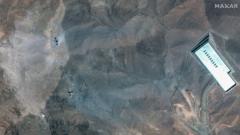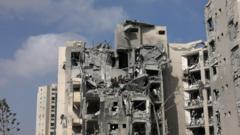As violence surged and military actions between these nations intensified, urgent diplomatic efforts culminated in a hard-fought agreement for peace, though threats linger.
**Ceasefire on the Edge: A 24-Hour Turmoil in the Middle East**

**Ceasefire on the Edge: A 24-Hour Turmoil in the Middle East**
In the wake of escalating tensions, a rapid sequence of events led to a fragile ceasefire between Iran and Israel.
In recent days, the situation in the Middle East has reached outstanding levels of volatility, highlighted by intense military exchanges between Israel and Iran. Following extensive damage to Iranian military assets since June 13, including missile attacks that compromised Israel’s defenses, a particularly chaotic period began Monday. This critical juncture saw a rapid escalation, which included an attack on a US air base, urgent mediation by the White House, and a near-collapse of a ceasefire agreement.
The tensions escalated in Qatar with a warning issued to US citizens advising them to "shelter in place" near the al-Udeid military base, the largest US military installation in the region. In retaliation for US airstrikes on Iranian nuclear sites, Iranian missiles were aimed at this pivotal base. Qatar's airspace was abruptly closed, while air traffic rapidly redirected as US defense mechanisms scrambled to intercept incoming threats.
Iranian media confirmed that missile retaliation had begun, and while the attacks were deemed a success nominally, they were leveled in such a way that major casualties were avoided, allowing Iran to assert it had retaliated without escalating into full-scale war. Diplomatic maneuvering followed swiftly, with US officials engaging both Iranian and Israeli leaders in urgent backchannel communications.
As US President Donald Trump intervened publicly—offering conciliatory messages indicating a desire for peace—the visibility of discussions about a ceasefire grew. Following crucial talks and media announcements, a ceasefire was swiftly declared, marking the conflict as "the 12 Day War." The arrangements were supposed to offer a respite from bloodshed, yet the situation remained perilous.
The subsequent hours saw continued missile exchanges, particularly from Iran, which marked the closing moments before the ceasefire. Israeli air defenses were operationally engaged, with casualties on both sides being reported, including a tragic hit on an Israeli apartment building.
Despite initial signs of agreement, by morning the ceasefire was questioned as both sides engaged in further strikes, threatening to dismantle the fragile peace established less than a day prior. Trump reiterated the importance of adhering to the ceasefire, urging both nations to de-escalate their military postures as tensions remained raw and volatile.
As the sun rose over Washington, the political implications of this rapid series of events left an indelible mark, with leaders vowing to pursue dialogue even amidst ongoing hostilities.
The tensions escalated in Qatar with a warning issued to US citizens advising them to "shelter in place" near the al-Udeid military base, the largest US military installation in the region. In retaliation for US airstrikes on Iranian nuclear sites, Iranian missiles were aimed at this pivotal base. Qatar's airspace was abruptly closed, while air traffic rapidly redirected as US defense mechanisms scrambled to intercept incoming threats.
Iranian media confirmed that missile retaliation had begun, and while the attacks were deemed a success nominally, they were leveled in such a way that major casualties were avoided, allowing Iran to assert it had retaliated without escalating into full-scale war. Diplomatic maneuvering followed swiftly, with US officials engaging both Iranian and Israeli leaders in urgent backchannel communications.
As US President Donald Trump intervened publicly—offering conciliatory messages indicating a desire for peace—the visibility of discussions about a ceasefire grew. Following crucial talks and media announcements, a ceasefire was swiftly declared, marking the conflict as "the 12 Day War." The arrangements were supposed to offer a respite from bloodshed, yet the situation remained perilous.
The subsequent hours saw continued missile exchanges, particularly from Iran, which marked the closing moments before the ceasefire. Israeli air defenses were operationally engaged, with casualties on both sides being reported, including a tragic hit on an Israeli apartment building.
Despite initial signs of agreement, by morning the ceasefire was questioned as both sides engaged in further strikes, threatening to dismantle the fragile peace established less than a day prior. Trump reiterated the importance of adhering to the ceasefire, urging both nations to de-escalate their military postures as tensions remained raw and volatile.
As the sun rose over Washington, the political implications of this rapid series of events left an indelible mark, with leaders vowing to pursue dialogue even amidst ongoing hostilities.























